When compiling our Fall 2013 TV Guide, I was disappointed by the lack of LGBT females we can anticipate blowing up our screenspace this season, especially following an unforgettable summer chock-full of scissoring Sapphics, bisexual bombshells and butch bomb girls. GLAAD‘s recently released Where We Are On TV report, which looks at the diversity of shows announced for the 2013-2014 season, did little to abate this concern. It also raised a lot of questions for me about how representation is measured and the reason why progress has come more quickly for some groups than others.
See, “Where We Are On TV” devotes its in-depth research to LGBT representation, but it also briefly tallies racial and gender diversity, offering multiple avenues from which to analyze representation’s quantification. If gay men and gay women are equally represented on network television, why doesn’t it feel that way? Has scripted television done its job if the percentage of women or people of color matches said group’s share of the U.S. population? If many of the LGB characters on television rarely or never address their sexual orientation, are they still worthy of our celebration? Why has LGB representation improved so much while PoC and female representation has stagnated? Let’s discuss.
TV Representation vs. Population Statistics

Measuring inclusivity and evaluating representation isn’t easy or straightforward, and one popular technique is comparing the percentages of certain groups on TV to U.S population statistics. Let’s look at how some of these comparisons stack up:
+ 43% of series regulars on scripted primetime television are female, but 51% of the country is female.
+ 77% of broadcast series regular characters are white, but 72% of the U.S. population is white.
+ 5% of broadcast series regular characters are Hispanic or Latino, but 16.3% of Americans are of Hispanic or Latino origin.
+ 11% of broadcast series regular characters are black, compared to 12.6% of the population.
+ 1.8% of the national population is bisexual, comprising 51% of those who identify as LGB. However, only 10% of LGBT network characters and 21% of LGBT cable characters are bisexual.
+ .001% of the 796 broadcast series regulars are transgender, but .03% of the national population is transgender.
+ The U.S. Census Bureau’s 2011 Community Survey found 12% of U.S. citizens report living with an apparent disability, but GLAAD found that even when including all characters who would be covered by the American Disabilities Act, which includes people not accounted for in the Census numbers (like HIV-positive people), only 1% of primetime broadcast series regulars have a disability.
So how do we judge how much representation is “enough” representation? Obviously the numbers for Latino/a Americans are beyond unacceptable, but what about the others? It seems ridiculous to argue that there are plenty of Asian-American and Pacific Islander characters on television, but the percentage represented on television (6%) actually exceeds the percentage of the national population identifying in those groups (5%). Asian Pacific American Media Coalition co-chair Daniel Mayeda told GLAAD that despite those numbers, “we continue to advocate for television series in which we are the main star.” Fox got an “F” from the APAMC this year for its API inclusion efforts because it “failed to provide the data the APAMC has consistently requested and which the other networks have delivered for over a decade.” Fox didn’t even care enough to participate in the APAMC’s television report card. It’s about quality, not quantity.
Nor does it feel as if African-American representation is anywhere near an acceptable level, despite being in the general neighborhood of its relative population, likely because as ColorofChange Executive Director Rashad Robinson told GLAAD, despite those numbers, “the quality of those representations remain a serious cause for concern.” They cite Scandal and Suits‘ “complex, multi-dimensional Black characters” as real progress, but lament that “too often viewers are exposed to portrayals of Black people that are dehumanizing and inaccurate.” Quality. Not quantity.
Similarly, in 2012 Gallup found that 3.4% of the U.S. population identified as LGBT, which isn’t that far off from our visibility on television (although the 3.4% number represents only those who are out — I personally suspect that number will creep gradually towards 10% over the next few decades). For the 2013-2014 TV season, GLAAD found 26 LGBT-identified series regulars on broadcast networks out of 796 total series regulars — 3.3%, down from 4.4% in 2012. Cable networks boast a more impressive 42 LGBT characters out of an unidentified total. But none of us queers here would argue that we’re anywhere near annihilating our symbolic annihilation.
Ultimately, it’s unlikely television producers are considering population ratios when planning TV schedules, which makes the usefulness of that evaluation metric shaky. Besides, if they were working from numbers like that, we’d probably see more programming reflecting the fact that women watch more TV than men and black people watch more TV than other racial groups. If TV was aiming to adequately represent the population it depicts in fictional programming, we’d see far more diverse casts, considering most television shows are set in the most diverse areas of the country, especially cities like New York City (56% nonwhite and 4.5% LGBT as of 2006) and Los Angeles (70.6% nonwhite and 5.6% gay as of 2006). Furthermore, despite the fact that women and nonwhite individuals are more likely to identify as LGBT, regular/recurring LGBT characters on broadcast and cable networks are are 72% and 71% white, respectively, and overwhelmingly male. It seems likely that onscreen representation reflects the demographics of television creators, not of the television audience.
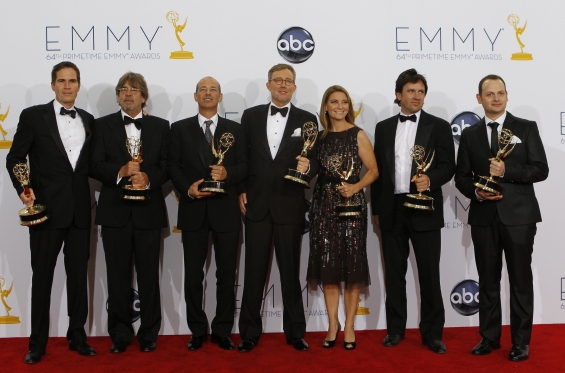
This is unfortunate, because television is our most powerful medium for destructing the ignorance fostered by our segregated country and affirming and empowering the identities of members of minority groups. The latter cause is being tended to reasonably well — thanks to one billion cable channels, it’s possible for women, queer people and people of color to find people like them on TV if they look hard enough. But when we’re talking about changing American hearts and minds, we have to look at how many characters from those groups are showing up on popular network shows with mainstream audiences, and the size and quality of those roles.
Our vice president credited Will & Grace with softening American attitudes towards LGB people and enabling same-sex marriage legislation, and many of us here credit various inclusive television shows with softening our attitudes towards ourselves as LGB people. On the flipside — when Gallup found that people of color, young people, women and people with lower levels of education and income were more likely to ID as LGBT, they noted that these results “run counter to some media stereotypes that portray the LGBT community as predominantly white, highly educated, and very wealthy.” This “positive” stereotype has actually proven legitimately damaging at times — in the Prop 8 trial, it was noted that many Americans don’t think gay people need marriage equality, hate crime protections or non-discrimination laws because according to Mitch and Cam, we’re all doing just fine! Wheee!
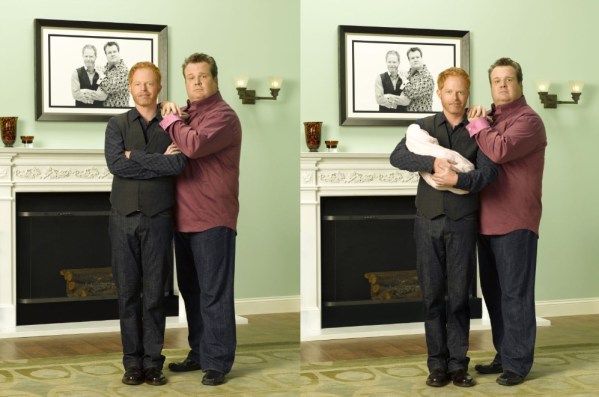
Media stereotypes remain: 56% of the LGBT characters GLAAD found were men. But a full 50% of the broadcast networks’ 46 regular and recurring LGBT characters are female, marking the first time in GLAAD history that females and males have been represented evenly. Quantitatively, this is a huge deal, but looking at the data qualitatively is a bit more complicated.
LGBT Female Characters on TV: The Quality Report
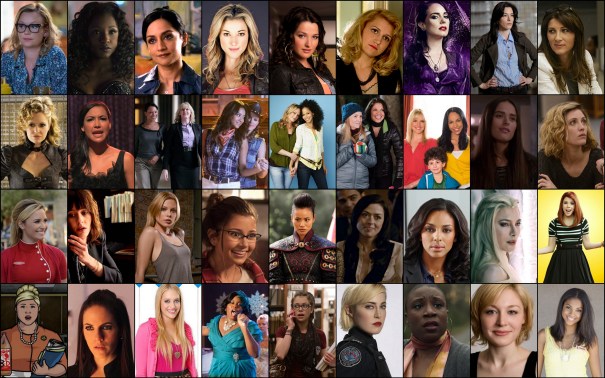
Queer women have a storied history of settling for less, or settling for subtext, when it comes to seeing ourselves represented on television. We make do with lesbian couples offering tentative pecks while hetero pairs suck face down the hallway and witness even our most celebrated and well-written queer characters see their relationship storylines sidelined while straight romances sit firmly at center stage (I’m lookin’ at you, Pretty Little Liars). Transgender women are rarely, if ever, portrayed on television, and you can count the positive portrayals of trans* women on television on one hand. (Also, they are rarely portrayed by trans* actors.)
Likewise, many of the women counted in this report aren’t necessarily candidates for Grand Marshall of the Northampton Pride Parade. For example, GLAAD promises that “new show Super Fun Night will feature a character named Marika who seems to have a strong attraction for the series lead; her female roommate.” Yup, a show which weekly begs the question “how many fat chick jokes can be squeezed into 22 minutes” will feature a sporty nerdy single lady who “can’t get a man” (that’s the premise of the show, that these three girls can’t get boyfriends) lusting after her straight best friend! How groundbreaking!
Many other characters who count quantitatively fail qualitatively: in Bones, GLAAD notes that “now that [Angela is] happily married to a man, her bisexuality is no longer addressed on the show.” On Mistresses, the relationship between label-free Josslyn and lesbian Alex was obnoxiously sidelined while hetero pairings took center stage — we’ve spent more time watching Josslyn cheat on Alex with a male colleague than seeing the two ladies get together! And while Unique’s inclusion on Glee is commendable as the only transgender woman on primetime television — and a transgender woman of color, at that — the show has dealt her a rotten hand all around (Catfishing, anyone?) and can’t seem to make it through an episode without using at least one unchecked transphobic slur.
Chicago Fire has been acclaimed for its main queer character Leslie Shay, but as a commenter shared in all-caps on our Fall 2013 Television preview, it recently featured a “crazy ex-girlfriend takes revenge through false rape accusation plotline,” which we all know is “the worst plotline in the history of humanity.” Nor will I be tuning in to misogynistic crap like Two and a Half Men plan to “feature a new regular LGBT character this season when the long-lost bisexual daughter of the former lead will move into her deceased father’s house.” I can sit through a lot of things in order to reach the lesbian parts, but not that. We were promised a new love interest for Kalinda on The Good Wife, but it was announced shortly after the GLAAD report debuted that this new love interest wouldn’t be showing up after all. Excited about that interracial lesbian couple on Under the Dome? Well, one half of that couple, Alice (played by Samantha Mathis), just died of a heart attack.
There’s some good stuff coming up though, too, like Santana’s new love interest on Glee (although her series debut came with an onslaught of biphoba), Callie and Arizona on Grey’s Anatomy (Arizona is now also the only series regular with a disability on ABC) and a promising thing brewing between Detective Gail Peck and Holly on Rookie Blue. Furthermore, Mulan was recently revealed to be bisexual on Once Upon a Time.
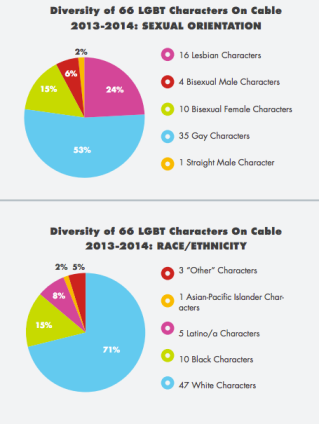
And although cable represents a smaller percentage of female characters compared to male, it’s got most of the good ones, like the lesbian Moms Lena and Stef of The Fosters, two bisexual scientists on Orphan Black, Emily and Paige on Pretty Little Liars, deaf lesbian character Natalie on Switched at Birth, Lost Girl‘s Bo and Lauren and Degrassi’s Fiona and Imogen. It’s also worth mentioning, however, that all the shows I just mentioned are either on ABC Family or imports from Canada or The UK. The best option for LGBT representation remains Orange is the New Black, a Netflix original not included in the GLAAD report.
Racial diversity amongst LGBT characters has been improving gradually, and it’s great to see so many interracial lesbian couples on television — but it would also be nice to see more same-sex female couples where both characters are of color, which happens approximately once in a blue moon (Emily & Maya on Pretty Little Liars, Santana & Dani on Glee, Kima & Sharon on The Wire… who am I missing?).
Alas, gay men still have it better. On network television they’ve got a much-lauded teenage romance and upcoming wedding for Kurt and Blaine on Glee and two huge spotlights for gay dads in Sean Saves the World and the Emmy-favorite Modern Family. Although queer women rock cable w/r/t character quality, queer men far outnumber queer women on cable and cable doesn’t provide the visibility network shows do: The Fosters miraculously pulled in a network high of 2.07 million viewers for its finale, but Modern Family regularly attracts over 12 million viewers a week and is the fourth most popular show on television. Yay for two wealthy white gay men constantly bickering, tricking and passive-aggressively undermining each other every week! (I love the show, but I hate their relationship!) It’s been a long time since we’ve had an entire show to ourselves, but HBO’s Looking, about three gay men in San Francisco, is currently filming for its 2014 debut.
Even though LGB representation isn’t at the levels we want it to be, it remains true that visibility for LGBs, and gay men in particular, has far outpaced that of women, trans* people, people of color and people with disabilities. This is especially remarkable when you consider how few LGB people exist compared to people of color. Regular/recurring LGBT characters on broadcast television has skyrocketed from 1.3% in 2006 to 3.3% in 2013, whereas for many people of color and women, progress has stagnated entirely. Check it out:
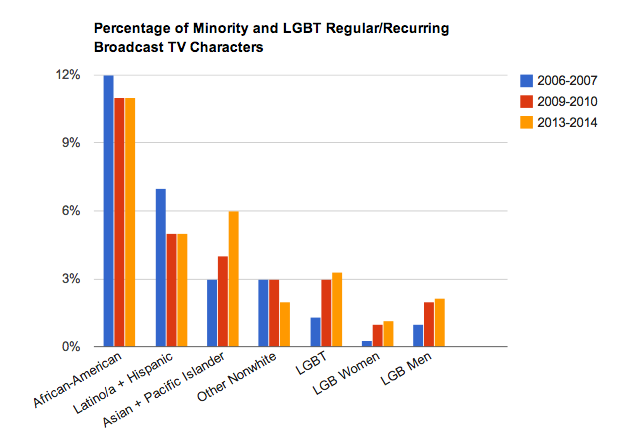
I didn’t make a graph about female representation because it has been at 43% for all of the above time periods, which would make a really boring graph. The number of transgender characters per year was too low to show up on the chart (there’s one now, there was one in 2009-2010 and zero in 2006-2007).
When will it get better for everyone?
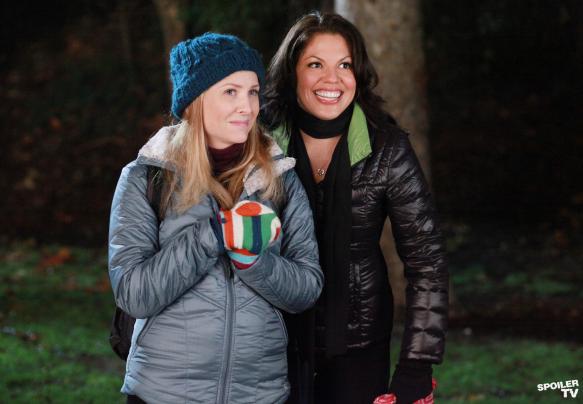
There are many explanations for this discrepancy in progress, like America is Really Fucking Racist and The Patriarchy, but I suspect a great deal of this can be accounted for by the composition of teams behind-the-scenes: only 26 percent of primetime network TV creators, executive producers, producers, writers, directors, editors and cinematographers are women, only 6.5 percent of TV writers are African-American, and people of color account for a mere 15.6 percent of behind-the-scenes TV employment. Nearly one-third of TV shows have no minority writers on staff and ten percent of TV shows have no women writers on staff. In terms of TV executive producers, women are underrepresented by a factor of more than 2 to 1, people of color at a factor of 5 to 1. The Emmys repeatedly fail to nominate or award people of color in any of its categories.
Hollywood has always been a homosexual haven, so it’s not a huge surprise that many gay characters have managed to evolve past Jodie Dallas while misogynist and racist material goes unchecked every day. Forget about it when it comes to transphobia and transmisogyny — transgender folks have been granted excruciatingly awful television representation throughout all of human history and even shows which aspire to political responsibility (like Glee and The L Word) fuck trans* stuff up. Although there are no numbers on it, I suspect this problem is enabled by a lack of trans* representation behind-the scenes (although Lana Wachowski (who recently produced the totally racist film Cloud Atlas) is working on a 2014 Netflix series called Sense8).
While it’s absolutely true that straight men have brought many gay characters to the screen on shows like Skins and Modern Family, most LGB characters on TV are the work of gay men and/or women (straight and gay). Gay men in particular are well-represented behind-the-scenes of shows that prominently feature gay, lesbian and bisexual characters, like Six Feet Under and True Blood‘s Alan Ball, The Fosters’ Peter Paige, Sex and the City‘s Michael Patrick King and Will & Grace‘s Max Mutchnick. Gay television producer Darren Star created Melrose Place, which featured one of the first gay television kisses ever, as well as gay-inclusive shows Sex and the City, 90210 and GCB. Gay Cuban-American writer Silvio Horta was the head writer, developer and producer for Ugly Betty. Gay showrunner Ryan Murphy is responsible for homo-heavy programs like Nip/Tuck, The New Normal, Glee and American Horror Story. Gay television writer and producer Russell T Davies made the first-ever American show entirely focused on gay men, Queer as Folk, as well as gay-friendly fare like Doctor Who and Casanova.
“Onscreen gay ubiquity has been greatly aided by the growing number of ‘out’ gay people in high places in the industry,” write Lillian Faderman and Stuart Timmons in the epilogue to Gay L.A. They also note that “lesbians have not yet had the same degree of prominence and success as have gay men in behind-the -camera Hollywood.” But they mention pockets of hope, like former HBO president Caroline Strauss. We’ve got lots more behind-the-screen advocates, though: it was Ellen Degeneres who brought us the groundbreaking Ellen and Ilene Chaiken who created The L Word. Comedian Carol Leifer created Rules of Engagement, which included a lesbian character played by Sarah Rue and Marlene King is responsible for the super-gay Pretty Little Liars.
If it’s not an LGB female writer/creator bringing a queer female to the screen, it’s likely to be Ryan Murphy, Alan Ball, Joss Whedon or a straight female writer/creator, such as Grey’s Anatomy‘s Shonda Rhimes and Orange is the New Black‘s Jenji Kohan. Furthermore, despite female underrepresentation behind-the-scenes of other shows, historically most shows with LGB characters of any gender have had a woman heading or co-heading its writing and/or creation, including South of Nowhere, Degrassi, Lost Girl, Bomb Girls, Lip Service, Roseanne, Weeds, The Good Wife, 30 Rock, The Carrie Diaries, Nashville, Girls, Emily Owens M.D., Smash, The Killing, Friends, Nurse Jackie, Mad Men, Awkward, Veronica’s Closet, Ray Donovan and The Masters of Sex.
Which brings me back to why progress seems quicker in some areas than others: White gay men occupy more “influencing” behind-the-scenes television positions than gay women, and thus gay men are more positively and frequently represented on TV than gay women.
Whereas highly stereotyped depictions of gay people have waned in recent years and numbers of gay people appearing in popular shows has increased, progress has stagnated and often reversed for people of color, despite the fact that research has shown that shows with diverse writing staffs and casts fare better in the ratings. In a 2013 study of writing staff diversity for the 2011-2012 TV Season, the only analyzed shows with significant PoC representation (over 35% of the writing team and/or 4+ PoC writers) on staff were BET shows (The Game, Let’s Stay Together, Reed Between The Lines), The Cleveland Show, Single Ladies, Key & Peele, Alphas, Criminal Minds, Family Guy, Grey’s Anatomy, Raising Hope, Nikita and Austin & Ally. That’s 13 shows out of 191. This is how shows like Outsourced even make it to air.
The instant the taboo around gay characters began crumbling, there were plenty of white gay men well-positioned in Hollywood to start telling their own stories; men like Ryan Murphy, Alan Ball, Scott Rudin, David Geffen and Darren Star. This was not the case for gay women, women or people of color when their various rights were allegedly won. Many are still fighting our way in, and it’s difficult when you consider that most showrunners, producers and writers do their time lower on the Hollywood totem pole for many years before being handed the reins themselves — which means our next lesbian television vanguard is probably already working in the industry. Maybe it’ll be Angela Robinson, Rose Troche, Katie Ford, Cherien Dabis or Ali Adler. Maybe it will be one of the ladies already making great television online, like Words With Girls‘ Brittani Nichols, Little Horribles‘ Amy York-Rubin, Unicorn Plan-It‘s Ashley Reed or Roomies‘ Julie Goldman and Brandy Howard. It might be you! Just please G-d, let it not be Ilene Chaiken.







